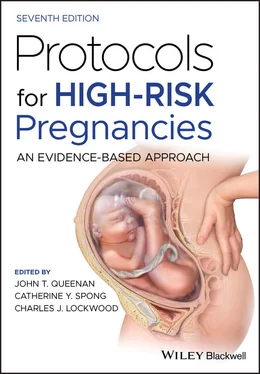The management of fetal anemia requires careful consideration of the etiological factors. The majority of cases will be due to RBC alloimmunization of the mother or parvovirus B19 infection.
Rh sensitization begins with identification of an isoimmunized patient from routine blood type and Rh, and antibody screening tests. When the antibody screen shows the presence of an antibody that places the fetus(es) at risk for fetal anemia, the patient needs to undergo serial screening with antibody titers. An alternative to serial antibody titers that is now more commercially available is the use of cell‐free (cf) DNA to see if the fetus carries the RBC antigen in question. If the antigen is absent in the fetus, no further testing is needed. If the antigen is present, the patient should be followed with antibody titers. Once a critical threshold has been reached by a specific titer of a given RBC antigen antibody, the patient must undergo evaluation for fetal anemia. Most hospital laboratories use either a 1:16 or 1:32 threshold cut‐off and it is essential that each practitioner knows the threshold for their particular hospital or laboratory. Once the critical threshold has been reached, the patient needs to undergo either (i) an amniocentesis for assessment of ΔOD450 in the amniotic fluid or (ii) MCA PSV assessment using pulsed‐wave Doppler velocimetry. If the latter is available, it should receive priority over the amniocentesis simply because it avoids the risk associated with the amniocentesis and has very good performance characteristics as a screening test for moderate to severe anemia. If an amniocentesis is performed and the ΔOD450 is in the high zone 2 or zone 3 of the Liley or Queenan curve, then that fetus must undergo fetal blood sampling for documentation of the anemia and transfusion (see Protocol 42). Alternatively, if the MCA PSV is used to assess fetal anemia, a 1.55 multiple of the median (MoM) value should be used as a threshold above which fetal blood sampling and transfusion are needed.
After one blood transfusion, the MCA PSV loses some accuracy and a different threshold for subsequent transfusion should be used (1.32 MoM has been suggested). The MCA PSV becomes increasingly less reliable for timing of subsequent transfusions and empiric intervals between transfusions are usually used: 7–10 days after the first transfusion, then two weeks until fetal bone marrow suppression is confirmed by Kleihauer–Betke stain and then three weeks thereafter. Administration of phenobarbital (30 mg PO TID) to enhance hepatic maturation can be considered at 34 weeks’ gestation or one week prior to delivery. Delivery of the anemic fetus receiving blood transfusion can generally be accomplished at between 36 and 37 weeks. If fetal blood sampling will be performed at a very preterm gestation, administration of betamethasone should be considered prior to the procedure.
Use of antiprostaglandin medications such as indomethacin for tocolysis results in inhibition of prostaglandin synthase activity and reduction in prostaglandin synthesis, which may constrict the ductus arteriosus. The effect on the ductus arteriosus is gestational age dependent and generally, indomethacin is not used beyond 32 weeks of gestation. A ductus arteriosus effect is not typically seen within the first 48 hours of treatment. Assessment of the velocity within the ductus arteriosus should be considered beyond that time if the patient continues prostaglandin synthase inhibitor therapy. Constriction is typically reversible with discontinuation of antiprostaglandin drugs.
Color and pulsed‐wave Doppler velocimetry are useful ultrasound tools for the evaluation and management of fetuses with fetal anemia, growth restriction, congenital heart disease, and fetal arrhythmias. While Doppler ultrasound has been used in other fetal conditions, no study has demonstrated any clear clinical benefit for its use outside those stated above. Widespread use of the DV flow velocity waveforms in the diagnosis of Down syndrome in the first trimester has not yet occurred. Although this is a noninvasive tool to assess for Down syndrome, the emergence of maternal cell‐free fetal DNA screening is far more accurate with extremely high sensitivity for the detection of this chromosomal abnormality. While uterine artery Doppler evaluation of the high‐risk pregnancy might identify a subgroup of women who are at higher risk for adverse pregnancy outcome, the use of Doppler should not be considered a standard medical practice in the general population until further studies demonstrate benefit.
1 American College of Obstetricians and Gynecologists. Fetal Growth Restriction. Practice Bulletin. No 204. Obstet Gynecol 2019; 133(2):e97–e109.
2 Baschat AA, Genbruch U, Harman CR. The sequence of changes in Doppler and biophysical parameters as severe fetal growth restriction worsens. Ultrasound Obstet Gynecol 2001; 18:571–7.
3 Biggio JR Jr. Bed rest in pregnancy: time to put the issue to rest. Obstet Gynecol 2013; 121(6):1158–1160.
4 Ciscione AC, Hayes EJ. Uterine artery Doppler flow studies in obstetric practice. Am J Obstet Gynecol 2009; 201(2):121–6.
5 Committee on Practice Bulletins‐Obstetrics. Practice Bulletin No. 181: Prevention of Rh D Alloimmunization. Obstet Gynecol 2017; 130(2):e57–e70.
6 Ferrazzi E, Bellotti M, Bozzo M, et al. The temporal sequence of changes in fetal velocimetry indices for growth restricted fetuses. Ultrasound Obstet Gynecol 2002; 19:140–6.
7 Galan HL, Jozwik M, Rigano S, et al. Umbilical vein blood flow in the ovine fetus: comparison of Doppler and steady‐state techniques. Am J Obstet Gynecol 1999; 181:1149–53.
8 Hecher K, Bilardo CM, Stigter RH, et al. Monitoring of fetuses with intrauterine growth restriction: a longitudinal study. Ultrasound Obstet Gynecol 2001; 18:564–70.
9 Hecher K, Snijders R, Campbell S, Nicolaides K. Fetal venous, intracardiac, and arterial blood flow measurements in intrauterine growth retardation: relationship with fetal blood gases. Am J Obstet Gynecol 1995; 173:10–15.
10 Lees C, Marlow N, van Wassenaer‐Leemhuis A, et al. Perinatal morbidity and mortality in early‐onset fetal growth restriction: cohort outcomes of the trial of randomized umbilical and fetal flow in Europe (TRUFFLE). Lancet 2015; 385:2162–72.
11 Mari G. Middle cerebral artery peak systolic velocity for the diagnosis of fetal anemia: the untold story. Ultrasound Obstet Gynecol 2005; 25:323–30.
12 Mari G, Deter RL, Carpenter RL, et al. Collaborative group for doppler assessment of the blood velocity in anemic fetuses. Noninvasive diagnosis by Doppler ultrasonography of fetal anemia due to maternal red‐cell alloimmunization. N Engl J Med 2000; 342:9–14.
13 Mavrides E, Moscoso G, Carvalho JS, et al. The anatomy of the umbilical, portal and hepatic venous systems in the human fetus at 14–19 weeks of gestation. Ultrasound Obstet Gynecol 2001; 18(6):598–604.
14 Moise KJ. The usefulness of middle cerebral artery Doppler assessment in the treatment of the fetus at risk for anemia. Am J Obstet Gynecol 2008; 198:161.e1–161.e4.
15 Moise KJ, Huhta JC, Sharif DS, et al. Indomethacin in the treatment of premature labor: effects on the fetal ductus arteriosus. N Engl J Med 1998; 319:327.
16 Reed KL, Anderson CF, Shenker L. Changes in intracardiac Doppler blood flow velocities in fetuses with absent umbilical artery diastolic flow. Am J Obsetet Gynecol 1987; 157:774.
17 Rizzo G, Arduini D. Fetal cardiac function in intrauterine growth retardation. Am J Obstet Gynecol 1991; 165:876–82.
18 Scheier M, Hernandez‐Andrade E, Fonseca EB, Nicolaides KH. Prediction of severe fetal anemia in red blood cell alloimmunization after previous intrauterine transfusion. Am J Obstet Gynecol 2006; 195:1550–6.
Читать дальше












